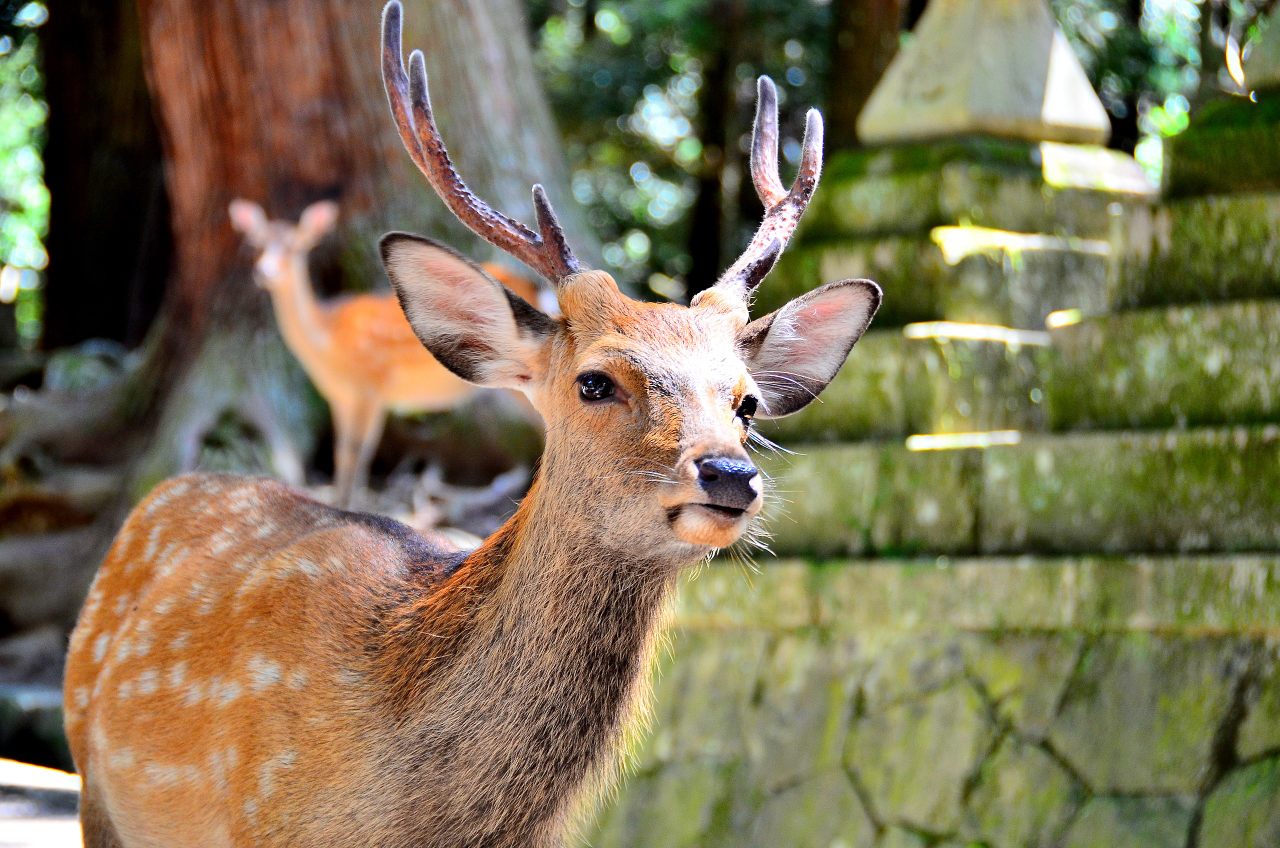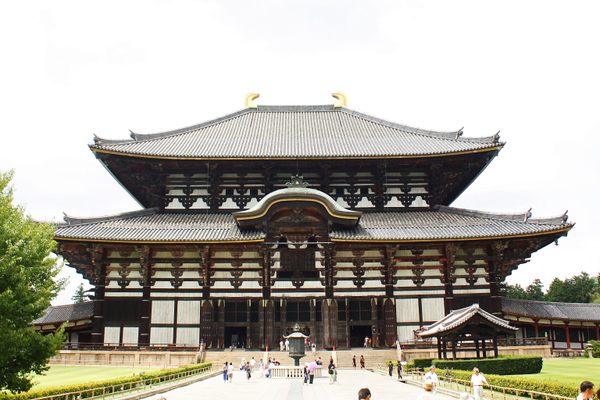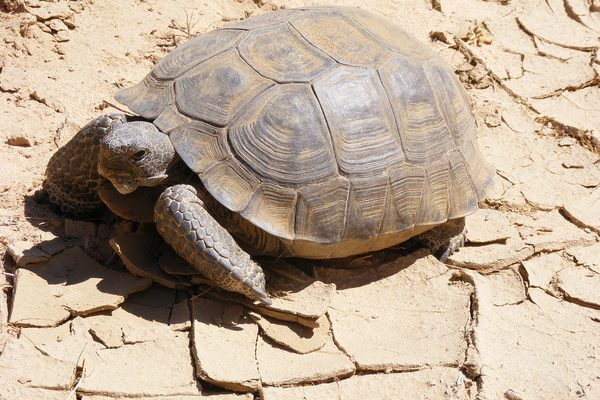Decoding the Sacred Genetics of Japan’s Sika Deer
The deer of Nara Park are part of a millennium-old genetic lineage—does that make them more deserving of protection?
A spotted buck with a full set of velvety antlers grazes peacefully among the ancient stone pillars of the Kasuga Taisha Shrine in Nara Park. At sunset, the sound of a trumpet draws in the buck and hundreds more deer to be fed crackers by tourists. While the 1,200 deer that live in the park are technically wild, their special relationship with humans goes back over a thousand years.
The sika deer, Cervus nippon, are considered sacred in Shintoism. Their spiritual status dates back nearly 1,400 years, to when Kasuga Taisha Shrine was built in what would later become Nara Park. It’s a largely undeveloped, natural area home to multiple religious monuments, nestled within the city of Nara, Japan’s ancient capital. Since then, the religious sanctuary around the shrine has protected the sacred sika deer from being hunted within its bounds.
But the deer don’t always stay within the sanctuary limits, and over the last 50 years, their numbers both inside and outside the protected area have skyrocketed. Increasingly more deer have taken up residence throughout the city of Nara and surrounding farmlands. Outside the sanctuary, farmers have long viewed the deer as nuisances, but the animals remain spiritually and culturally significant—and a major draw for tourists. In 1985, the national government heard farmers’ pleas and divided the city of Nara into protected and managed areas for the deer. In managed areas, culling—or killing—the animals is allowed. So far it hasn’t happened, but only because locals fear a cull would turn away Instagrammers and other economically valuable tourists.
Now, there’s a new wrinkle to the story: determining the sacredness of an animal based on its genetics.

A recent study published in the Journal of Conservation Science and Practice shows that the deer in the Nara Park preserve today are genetically unique from deer populations in the surrounding area, preserving the DNA of their sacred ancestors. The findings may influence how the people of Nara value different deer populations, both spiritually and culturally, based on their genetics, says coauthor Shingo Kaneko at Fukushima University. Those values, and the emotions that come with them, could play a role in how growing populations of deer are managed inside and outside of the reserve to protect the animals’ unique genetic legacy.
Deer inside Nara Park have long enjoyed special treatment. According to local folklore, Takemikazuchi, one of the four gods of the Kasuga Grand Shrine, arrived one day around the year 768 on the back of a white deer. Since then, the people of Nara have considered the sika deer sacred messengers, watching over the city. Until 1637, killing a sacred deer was punishable by death—and even after that, few dared try. After World War II, the deer within the sanctuary were designated natural monuments, further safeguarding their protection and cultural significance. Outside the religious sanctuaries, deer were hunted, all but extirpating them from the area around Nara and leaving the sanctuary population isolated for over a thousand years.
This isn’t the only case of traditional taboos protecting species. Bougainville monkey-faced bats, for example, have been protected for their cultural and spiritual significance in Papua New Guinea. As human values, economies, and land use change around the world, so does conservation, and the sacred deer of Nara are no exception.
In many areas of the world—including elsewhere in Japan—culling deer is a common solution to overpopulation. Tradition and tourism complicate the situation in Nara. “This is an animal that has been loved despite its problems,” says Kaneko.
In 2023, Kaneko and his colleagues redefined the history of the deer of Nara Park. They showed that the genetic lineage of the deer in the preserve around the Kasuga Taisha Shrine dates back over a thousand years. “This was a major discovery and was the talk of the town in Japan,” says animal population geneticist Naoki Ohnishi at Tohoku Research Center in Japan, who was not involved in either study.

While this research reasserted the status of Nara Park’s sacred deer, people were unsure of how to feel about the animals wreaking havoc on crops outside the reserve, especially those in close proximity, says Kaneko. “Deer that appear there are strongly perceived as having come from Nara Park,” he says. “The designation as natural monuments, along with the notion that they might be sacred deer, likely acted as a deterrent against deciding to cull them.”
Kaneko and his colleagues’ new research sought to settle the uncertainty. After comparing genetic samples from the preserve deer with those of populations from across 30 different sites, the researchers determined that deer in managed areas and beyond were of mixed genetic heritage, while those within the Kasuga Taisha Shrine reserve were more homogeneous, representing a “…pure lineage spanning more than a thousand years,” as Ohnishi puts it. As mixed heritage deer continue to populate the areas surrounding Nara Park, they could threaten the unique genetic signature of the population within the preserve. “The question now is whether we continue the management policies that have been in place for over a thousand years, or change these policies to end the isolation that has lasted for more than a millennium,” says Kaneko.
Genetic research like this can sway people’s beliefs and emotions, and has practical implications for how we manage wildlife. “This genetic information will likely influence people’s opinion,” says Kaneko. Ohnishi agrees this work could have real-world impacts. “This paper will provide an opportunity for the people of Nara prefecture and the citizens of Nara to reconsider their management policies for deer in the region.”
The research begs the question, can genetics determine the spiritual value of an animal, or its right to protection? “It is difficult to answer the question of whether it is more sacred. However, there is a big difference in the length of time they have lived in Nara Park area,” says Kaneko, who thinks that, instead of being deemed sacred, the deer might be more appropriately considered “living cultural assets.”
Today, as the trumpet sounds and deer gather around for crackers, the people of Nara consider not just the animal’s long lineage, but what they’ll do to preserve it.
































Follow us on Twitter to get the latest on the world's hidden wonders.
Like us on Facebook to get the latest on the world's hidden wonders.
Follow us on Twitter Like us on Facebook